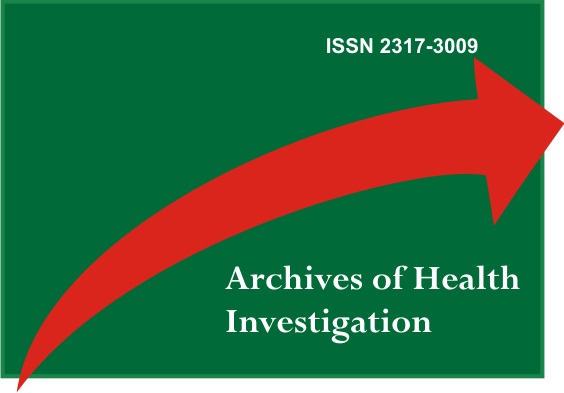Success after endodontic retreatment: importance of cleaning and disinfecting the root canal system
DOI:
https://doi.org/10.21270/archi.v10i8.5095Keywords:
Endodontics, Retreatment, Conservative Treatment, Calcium Hydroxide, FistulaAbstract
Introduction: The persistence of microorganisms is one of the determinants of endodontic treatment failure, which occurs due to iatrogenesis, pathologies and negligence. To solve this problem, dental extraction or a more conservative treatment - such as endodontic retreatment, may be indicated. Objective: The aim of this article is to report a clinical case of failure of the primary endodontic treatment and the success in the retreatment approach that culminated in the positive outcome of the clinical case. Clinical case: A patient with painful symptoms on chewing in tooth 26 was diagnosed with chronic apical periodontitis with periapical radiolucency using clinical and radiographic propedeutics for endodontics. Endodontic treatment was performed and 1 year after its completion, the patient had a recurrent fistula and it was proposed to extract the tooth in question. Dissatisfied with the treatment plan, she sought a second opinion and endodontic retreatment was performed in multiple sessions with the use of calcium hydroxide as an option for intracanal therapeutic medication. After 60 days of intracanal medication, filling of the root canal system and dental rehabilitation were performed. Conclusion: The success of the endodontic treatment depends on the excellent cleaning and disinfection of the root canal system and consequently airtight filling; the persistence of microorganisms is one of the factors that can determine an unfavorable prognosis and a new endodontic reintervention can lead to success, despite radical alternatives, such as extraction and rehabilitation with implants. Through the presented clinical case, it is concluded that the meticulous planning and the execution of the treatment based on scientific evidence lead to the success of more conservative treatments for the patient and their satisfaction.
Downloads
References
Yamaguchi M, Noiri Y, Itoh Y, Komichi S, Yagi K, Uemura R et al. Factors that cause endodontic failures in general practices in Japan. BMC Oral Health. 2018;18(1):70.
Prada I, Micó-Muñoz P, Giner-Lluesma T, Micó-Martínez P, Collado-Castellano N, Manzano-Saiz A. Influence of microbiology on endodontic failure. Literature review. Med Oral Patol Oral Cir Bucal. 2019;24(3):e364-72.
Yücel O, Ekici MA, Ilk O, Ilhan MN, Kayaoglu G. Predicting intraoperative pain in emergency endodontic patients: clinical study. Braz Oral Res. 2018;32:e38.
Torabinejad M, White SN. Endodontic treatment options after unsuccessful initial root canal treatment: Alternatives to single-tooth implants. J Am Dent Assoc. 2016;147(3):214-20.
Chatzopoulos GS, Koidou VP, Lunos S, Wolff LF. Implant and root canal treatment: Survival rates and factors associated with treatment outcome. J Dent. 2018;71:61-6.
Santos-Junior AO, De Castro Pinto L, Mateo-Castillo JF, Pinheiro CR. Success or failure of endodontic treatments: A retrospective study. J Conserv Dent. 2019;22(2):129-32.
Clark D, Levin L. In the dental implant era, why do we still bother saving teeth? Dent Traumatol. 2019;35(6):368-75.
Sebring D, Kvist T, Derks J. Indications for Extraction before Implant Therapy: Focus on Endodontic Status. J Endod.2019;45(5):532-37.
Lacerda MFLS, Coutinho TM, Barrocas D, Rodrigues JT, Vidal F. Infecção secundária e persistente e sua relação com o fracasso do tratamento endodôntico. Rev Brasileira de Odontol. 2016;73(3):212-17.
Del Fabbro M, Corbella S, Sequeira-Byron P, Tsesis I, Rosen E, Lolato A et al. Endodontic procedures for retreatment of periapical lesions. Cochrane Database Syst Rev. 2016;10:CD005511.
Kang M, In Jung H, Song M, Kim SY, Kim HC, Kim E. Outcome of nonsurgical retreatment and endodontic microsurgery: a meta-analysis. Clin Oral Investig. 2015;19(3):569-82.
Di Fiore PM, Tam L, Thai HT, Hittelman E, Norman RG. Retention of teeth versus extraction and implant placement: treatment preferences of dental faculty and dental students. J Dent Educ. 2008;72(3):352-58.
Setzer FC, Kim S. Comparison of long-term survival of implants and endodontically treated teeth. J Dent Res. 2014;93(1):19–26
Parirokh M, Zarifian A, Ghoddusi J. Choice of Treatment Plan Based on Root Canal Therapy versus Extraction and Implant Placement: A Mini Review. Iran Endod J. 2015;10(3):152-55.
Angeletaki F, Gkogkos A, Papazoglou E, Kloukos D. Direct versus indirect inlay/onlay composite restorations in posterior teeth. A systematic review and meta-analysis. J Dent. 2016;53:12-21.
Pratt I, Aminoshariae A, Montagnese TA, Williams KA, Khalighinejad N, Mickel A. Eight-Year Retrospective Study of the Critical Time Lapse between Root Canal Completion and Crown Placement: Its Influence on the Survival of Endodontically Treated Teeth. J Endod. 2016;42(11):1598-603.
Stenhagen S, Skeie H, Bårdsen A, Laegreid T. Influence of the coronal restoration on the outcome of endodontically treated teeth. Acta Odontol Scand. 2020;78(2):81-6.


